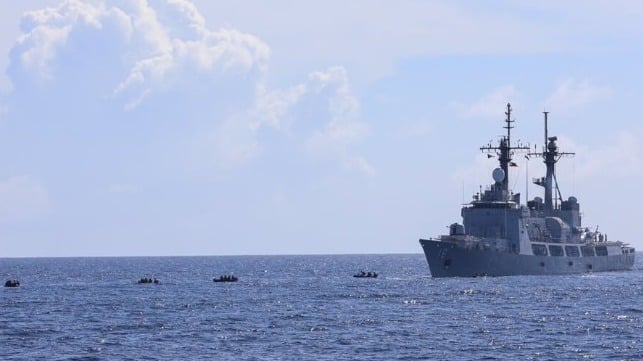Ex-U.S. Coast Guard Cutter Hosts Island-Seizing Drill in Spratly Islands

This week, the former U.S. Coast Guard cutter USCGC Dallas got to play a role that her builders never anticipated: flagship of a closely-watched amphibious assault exercise in the South China Sea.
Dallas - now named BRP Ramon Alcaraz - was a Hamilton-class high endurance cutter built in 1968 at Avondale Shipyard. After decades of service in the U.S. Coast Guard, she was decommissioned in 2012, refitted and transferred to the Philippines. She is one of three former Hamilton-class cutters in the Philippine Navy's fleet.
On Wednesday, the BRP Ramon Alcaraz served as the launch platform for a mock amphibious assault on Kota Island, a Philippine-held island in the Philippines' western exclusive economic zone. With warships and intelligence vessels from China's PLA Navy watching from a distance, Alcaraz launched four RIBs with Philippine SEALs and Marines aboard. Supported by two patrol boats and a light aircraft, they simulated an operation to retake an island seized by an enemy force.

Courtesy PCG
It was the first time that the Philippines had carried out a drill at Kota Island, a small outcropping of sand located just 25 nautical miles southeast of the giant Chinese military base at Subi Reef. China has seized and fortified more than half a dozen shoals in the Spratly Islands, creating airfields and sheltered harbors on a scale not previously seen in the region. Manila has long expressed concern that Chinese forces might try again at another contested site - perhaps at Sabina Shoal, Second Thomas Shoal or Whitsun Reef, where Chinese and Philippine servicemembers have recently clashed.
"In all our exercises, they are defensive. We are not the ones attacking. These are defensive exercises that we are doing. The assumption is that we want to reclaim our own island," Armed Forces of the Philippines chief of staff General Romeo Brawner Jr. told ABS CBN.
A reporter for the outlet counted two PLA Navy warships within visual range during the exercise, the corvettes Wuzhou and Tongling, along with four Chinese research vessels. The exercise was partly for their benefit, Brawner suggested.
"We are warning our neighbors or any external forces out there that we are capable of defending our islands, and we can do so unilaterally - meaning, by ourselves," he told the Philippine Star.
